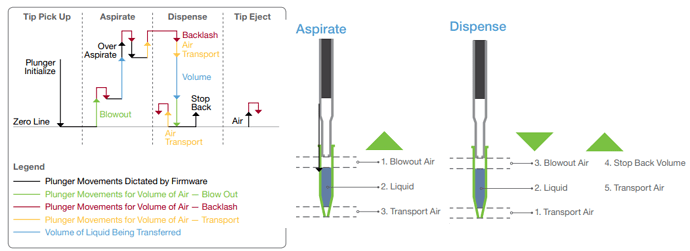@yunghans - Congrats on writing and testing your first method! A significant milestone and hopefully the first of many.
Regarding your questions, you’ll see my responses below but I wanted to use this opportunity to plug the Liquid Handling E Book found on the Hamilton forum material’s share.This is a fantastic educational resource for lab automation new comers and still serves as great reference material for seasoned experts. You may have already come across this, but wanted to link it in case you hadn’t. There are plenty of pointers and best practices for numerous liquid handling situations.
In short, yes. When reusing tips for n number of aspiration and dispense iterations, it is recommended to pre-wet the tip prior to or during the first aspiration. Whenever a dispense is completed, there will always be a small amount of residual liquid left behind coating the inner-surface of the tip as a film, which may eventually collect to the bottom of the tip if left long enough.
For n number of reuses, the amount of residual liquid left within the tip is typically consistent after each dispense, which will result in consistent volumes being delivered. However, if the tip is not pre-wet prior to the first aspiration, this residual volume left in the tip will be deducted from the dispense delivery volume relative to the subsequent dispenses, meaning your first dispense volume may be slightly lower than subsequent. Based on the requirements and volumes of the assay, this may be acceptable, but it is best practice to avoid.
Pre-wetting once for n number of cycles will result in a shorter time to complete pipetting than overaspirating and having to empty the overage with each iteration. Even if that wasn’t a concern, you would still succumb to the same dispense shortage on the first dispense.
Additionally, for dispensing volatile liquids (whether or not you intend to reuse tips) pre-wetting is essential for equilibrating the vapor pressure of the solvent in the tip prior to aspirating and dispense. This will reduce any backpressure built up in the headspace of the tip generated by the solvent and help prevent droplets from forming.
You have several options, and the route chosen may be dictated by cross contamination concerns depending on the existing contents (or lack thereof) in the wells of the plate being dispensed to. I’ll provide options for both scenarios:
Scenario A: Wells already contain material that would cause cross contamination in other wells - surface dispensing not an option for tip reuse.
Option 1: Optimize liquid class for dispense jet empty
As @dominik.b suggested, you may want to look into tweaking some parameters used for the liquid class. Dispense speed, stop rate, blowout volume and air transport volume can all be relevant for bubble prevention (or formation) when using a jet empty liquid class depending on the liquid being used. You can find specific pointers in the linked guide. If you are only getting a bubble once in every 25 iterations, you are likely pretty close already.
Option 2: Employ reverse pipetting (cheat code)
One of my favorite tricks when having to reuse tips for dispensing challenging liquids that are prone to bubble formation during tip reuse (high viscosity and/or loaded with foamy surfactants) is to use a technique called reverse pipetting:
On the initial aspiration, intentionally over-aspirate by an arbitrary amount (depends on tip size, dispense volume, liquid class correction curve etc) and then use a dispense jet part liquid class to deliver the required volume on dispense. For subsequent aspirations you should toggle ‘consecutive aspiration’ mode in the aspiration step to prevent additional airgaps, but only aspirate the required volume, continuing to jet part on dispense. The additional back volume kept with each dispense in the tip, along with the lack of additional air gaps help tremendously. After all dispenses, you can either empty the overage back into the source labware or throw away on tip eject.
Of course this technique is only an option if the required dispense volume is lower than the max allowed by the tip type/liquid class.
Scenario B: Wells are either empty, or contain material that will not contaminate other wells - surface dispensing is an option for tip reuse
If this is the case, it is basically silver bullet to use a surface dispense. If the wells already contain a minimum amount of conductive liquid, you can use cLLD on dispense. If the wells are empty or cLLD isn’t an option, you can still use a surface dispense - but you can use a fixed height such that the tip will self-submerge upon completion of the dispense (based off of the final volume in the well and the container geometry). Check the following post for similar discussion on this technique.
Surface dispensing tips
Surface dispensing whether using liquid level or fixed heights will eliminate any bubbles.
Hope this helps. Thanks.
-Nick
![]() ).
).![]()

